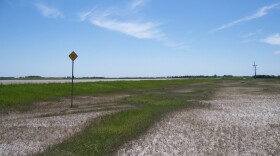Duck nests have been a topic of discussion in the Prairie Public radio department recently. Director of Radio Bill Thomas and Producer Skip Wood were surprised to learn they each had a hen mallard nesting in their yard, but the location was a bit disconcerting. Except for a small pond on the Concordia College Campus, the nearest water, the Red River, is around 10-12 blocks away.
So why does a duck nest so far from water? Will the ducklings need some help getting to the water? And what if anything should one do about it? Those questions come up occasionally when a duck nests far from water or in an unusual place.
Some ducks, wood ducks, buffleheads, goldeneyes, and mergansers, for example, are cavity nesters. They nest in hollowed out tree trunks and the like. And although diving ducks may nest on land, scaup, canvasbacks, and others are known to build their nests of floating vegetation well concealed amongst the emergent vegetation. It might seem contradictory, but dabbling ducks, such as mallards, teal, and northern pintail, are upland nesting birds, typically nesting amongst vegetation in uplands some distance from a body of water.
So how close to a body of water do these ducks nest? As you might expect, distances can vary considerably. Teal tend to nest closer to water than mallards. And although most mallard nests will be within a hundred yards or so from a body of water, they are known to nest up to a mile or more away.
Why so far from water? Several factors may influence nest site selection for ducks and other birds. Maybe suitable nesting cover is not available nearer the water. Nesting farther away may serve to reduce predator risk. And in the case of mallard hens, getting away from over aggressive drakes during the breeding season may be a big contributor.
So what should a person do if a duck nest is disconcertingly far from water? In short, nothing. The birds and nests are protected under federal law. Furthermore, the hen certainly has knowledge of the surrounding area, including proximity to water. She should know what she is doing, and the ducklings will likely be able to walk the distance to water. We need to remember that the ducklings are precocial, which means that they can walk and feed within a few minutes of hatching. The trip will not be without risk, but the ducklings should be physically able to make the trip.




